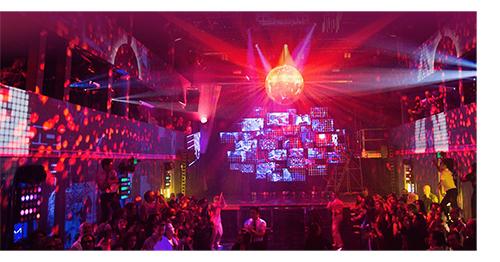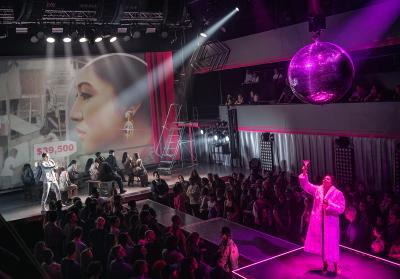The Broadway Theatre on W. 53rd Street made design history in 1974 when Eugene Lee moved Candide from the Chelsea Theater Center, a small theater housed on the fourth floor of the Brooklyn Academy of Music, to Broadway. Lee gutted the seats in orchestra, sat audiences on stools and bleachers, while Hal Prince blocked action around, between, and over them. The Chelsea Candide, as it came to be called, was the first experiment in environmental/immersive staging on Broadway. (Fun fact: the Chelsea wanted to hire 13 musicians at the Broadway as it had in Brooklyn; the musician’s union objected to the small number.)
In 1974, however, experiments in what was called “mixed media” were rare. The Chelsea had a few televisions on stage for one Brooklyn show, a large screen for another, which scenic designers used to extend action or comment on it, but nobody specialized in projection design. It was never considered for Candide.
Today, of course, it’s a rare musical that doesn’t count a projection designer as an essential member of the artistic team. And when director Alex Timbers decided to turn the theater into a disco for Here Lies Love, with galleries around the dance floor, he relied on David Korins to re-imagine the space—and for Peter Nigrini to fill it with video that helps tell the story and clarify the themes.
Nigrini, who has designed on and off-Broadway and at top regionals and opera houses, has been recognized with awards that include a Drama Desk for Outstanding Projection Design, a Special Lortel Award for Grounded, and the 2013 Hewes Design Award for Here Lies Love.
2013! It’s been a decade since Here Lies Love, the immersive disco pop musical that tells the story of the rise and fall of Imelda Marcos and the People Power Revolution of the Philippines, opened at the Public Theatre.
The changes may not have been as dramatic as they were between 1974 and 2013, but changes there have been as the David Byrne/Fatboy Slim musical made its way to Broadway, via London and Seattle.
Video and images are everywhere, recorded and live. “The content starts before the house opens and ends when the last audience member leaves. There are maybe 45 seconds without images," Nigrini says.
The way video is made is among those changes. We developed a lot of tools for Here Lies Love that we’ve been using ever since,” says Nigrini. These tools make it possible to rapidly make large volumes of content—and manage them. “In the first production, we developed a lot of this content. We’ve been using it, refining it, and adding to it ever since. Also, when we did this at the Public, there weren’t playback systems [that could function on this huge scale]. From a technical standpoint, scale is a huge part of what’s changed.”

“The other thing that I’m excited about is not just the technology and mechanics but the core of what projection design is doing. So much of the story telling is visual,” Nigrini says, explaining that while the book and lyrics moved the story forward in classical musical theater, it doesn’t always do that today. It became part of his job to show people who Marco is, who Imelda is, “and more deeply what’s the relationship between their rise to power, their American supporters, and the impact they and their American sponsors had on the Philippines. Elucidating that story line is a large part of the design.”
Nigrini uses historical images and archival footage to help. "We’re seeing the actual history…which helps us efficiently tell the story with the exuberant music."
Of course, if you’re telling a story visually, you want the audience to see it, all of it. That can be challenging if audience members are looking at it from different directions.

While some are engaged in distracting activities, like enjoying a dance at a disco, and ignoring images, others sitting in conventional seats may be focused on these images at the same time. “It’s not just delivering images or projected scenery but delivering information. A unique challenge in this production is how to make the diverse experiences of the show equally good, but different,” Nigrini says, adding that live cameras are telling the story, too. “A young girl is becoming a star. It’s a story about media, television, and politics. People experience the show both in person [actors in the environment] and camera images [of actors in the environment] and we watch the conflicts play out in part in this mediated sphere, as they do in life.”
The first production at the Public Theatre relied on a single live camera. Now there are 10, “to make sure we’re capturing all of those moments and allowing people to see things they may have missed; we’ve been able to insure people are having a more consistent experience than before.”
The team had worked in a proscenium space once before, at the Seattle Rep in 2017 (see video below) and began the process of making sure what was originally a show for people on the dance floor and those seated around it, would also work for a mezzanine audience.
That’s only one of the challenges of mounting such a large production. Nigrini talks about how he addressed others in Part 2 of this article (stay tuned).
Gear List
Supplier
Servers
- (1) d3 gx2c
- (3) d3 vx4
Projectors
Monitors
- (52) Samsung QH/QB Series Digital Signage Displays
Cameras
- (8) Panasonic AW-HE130 PTZ
- (2) Sony PWM-200 Camcorders
- (2) Teradek Bolt 3000 Kit
Infrastructure
- Imagine Communications Platinum MX Routing System with integrated multiviewing and optical transmission.
- Barnfind BTF1 Series matrix frames
Networking
Crew List
- Associate Projection Designer Robert Figueira
- Assistant Projection Designer Zoey Crow
- Lead Animator C. Andrew Bauer
- Animators:
- Dan Vatsky
- Kate Ducey
- Lacey Erb
- Lisa Renkel
- Ryan Belock
- Johnny Moreno
- David Bengali
- Projection Programmer Ido Levran
- Production Video Asher Robinson
- Deck Video/LX Adam Bishop